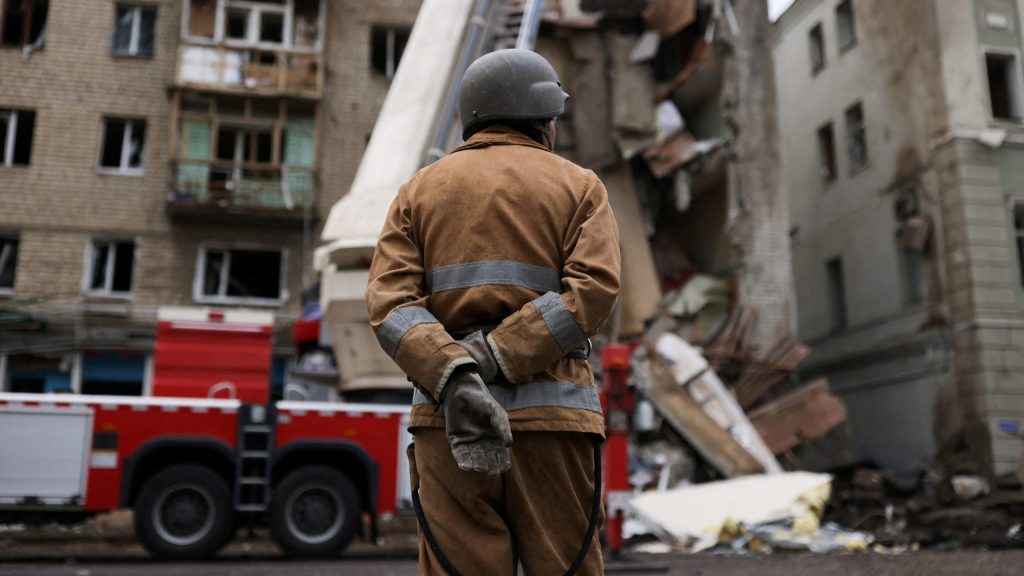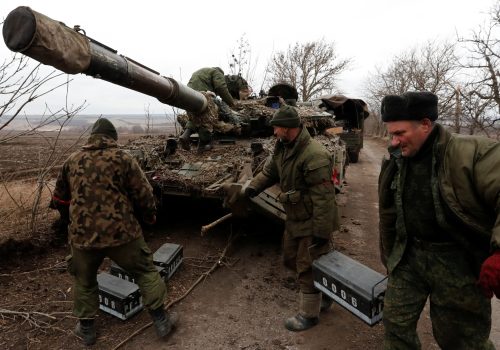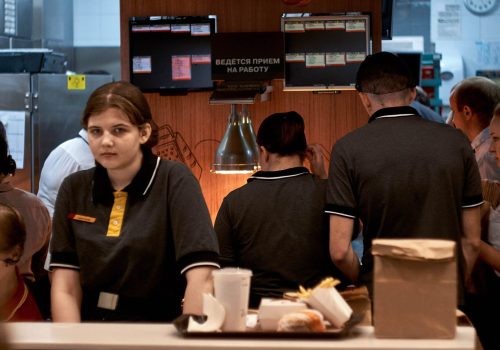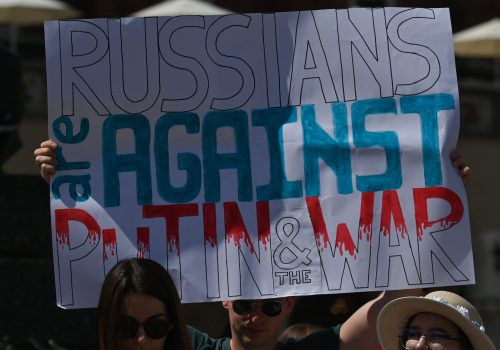It’s the war that was both eminently predictable and roundly unpredicted. If ever there has been a conflict that underscored the urgent need in the policy world for strategic foresight, it’s the one currently raging in Ukraine. For months, our foresight experts have been projecting how the war could break out and, once it did, how it could unfold next. In this latest installment, Barry Pavel, Peter Engelke, and Jeffrey Cimmino revisit their March forecasts for four different scenarios.
In early March, soon after Russia invaded Ukraine, we proposed four scenarios for how the war might unfold. At that time, we noted that several factors suggested it was turning in the West’s favor, including popular international support for Ukraine, Kyiv’s determination to fight, and newfound transatlantic solidarity. Since then, Russia’s initial offensive has collapsed, transatlantic allies and partners have become bolder in their actions, and NATO appears poised to admit Finland and Sweden.
Four months later, we find it important to revisit our thinking: Foresight is a strategic exercise that requires returning to the original evidence; the assumptions and scenarios should be modified in accordance with actual events. If the scenarios are built on faulty assumptions, or if they are poorly calibrated to events on the ground, they will not be useful for policymakers seeking to develop coherent strategies.
So here, we reexamine our four original scenarios and suggest how we might amend them in light of new developments in Ukraine:
Scenario 1: Miracle on the Dnipro
In this scenario, we forecast the possibility—seen as remote in early March—of an unexpectedly strong Ukrainian resistance forcing Russia to execute a swift withdrawal from Ukraine. This scenario now appears to be no miracle, as a Ukrainian battlefield victory is more likely today than it appeared in early March.
July update: Strengthened by Western sanctions against Russia and the provision of increasingly lethal military equipment, Ukraine weathers Russia’s offensive in the east. With better equipment, higher troop morale, and superior leadership and tactics, Ukraine launches powerful counteroffensives (as they have already done around Kharkiv, where they have pushed back Russian forces to the border) and expels Moscow’s troops from occupied Donetsk and Luhansk, as well as from southern Ukraine—where they retake Mariupol and other territory along the Sea of Azov. Then, they prepare for an assault on Crimea.
Ukraine’s advances are met with increasingly strident escalatory threats from the Kremlin. Although Moscow had degraded the shock value of such threats long before through sheer repetition, both Western and Ukrainian intelligence services place greater weight on the nuclear threat this time because they believe attacking Crimea is a true red line for Moscow.
This is the moment when Russia and Ukraine reach an agreement to end the war. Ukraine agrees to stay out of NATO, while Russia agrees to respect the country’s pre-2014 borders (minus Crimea, the resolution of which is put on indefinite hold) and Kyiv’s quest for membership in the European Union (EU). Russian President Vladimir Putin nonetheless attempts to claim a victory and walks away, his attention shifting to his increasingly fragile domestic power base.
The transatlantic community is rejuvenated. As a nuclear-armed state, Moscow remains dangerous but its conventional forces are battered. Finland and Sweden join the Alliance, and despite Russian warnings to both countries, their accession is a peaceful one (Putin indicated he would accept Finnish and Swedish membership with conditions). Overall, the European security situation is better for NATO, with Russia weakened and dissuaded from further military adventures and members more united.
Scenario 2: A quagmire
In this scenario, we forecast the possibility—seen as likely in early March—of Russia managing to take Kyiv, topple Ukraine’s government, and install a puppet government. However, we also forecast a pyrrhic victory for Russia, as Ukrainians mounted a “broad-based, well-armed, and well-coordinated insurgency.” While this scenario will not play out as written, some elements of it could—specifically the distinct possibility that low-intensity conflict in Ukraine will continue for years to come.
July update: Although Russia proves incapable of realizing its original maximalist war aims, it manages to dig in along new front lines in eastern and southern Ukraine, hold a land bridge to Crimea in the south, and protect the separatist regions of Donetsk and Luhansk in the east. While Ukrainian forces have secured their capital and protected their country’s sovereignty, they are unable to expel Russian forces to their pre-February 24 positions. The war settles into a mostly frozen conflict, with neither side able to achieve victory.
The war in Ukraine becomes a years-long drag on Europe due to the economic difficulties associated with ever-tightening sanctions. The prospect of a newly intensified or broader European conflict lingers over the continent, while governments wrestle with competing domestic pressures over how much to support Ukraine. Russia seeks to terrorize Kyiv and cities in western Ukraine with long-range missile attacks, while conflict periodically flares up along the front lines. An increasingly well-armed Ukraine easily manages to fend off Russian ground attacks, but in general it proves unable to retake the separatist territories, heavily entrenched Russian positions on the land bridge, or Crimea. Although bolstered by deepened ties with the EU, Ukraine’s economy is hit hard by Russia’s ongoing stranglehold of its Black Sea ports, which prevents bulk exports of grain.
There is no clear end to the war, and neither side appears willing to give up what it has already invested in reputation, people, and money.
At home, Putin can claim some semblance of a victory, having secured territorial gains in eastern and southeastern Ukraine and solidified his hold on Crimea through a land bridge. Overall, Russia’s position in Ukraine is stable, though it expends substantial resources securing its territorial gains. Yet the war is hardly a wash for Russia: Moscow continues to face severe economic and diplomatic pressure from abroad, especially as Europe reduces its dependence on Russian energy and many Western sanctions remain in place.
Scenario 3: A new Iron Curtain
In this scenario, we forecast the possibility—seen as plausible in early March—of Russia managing to take Kyiv, topple Ukraine’s government, install a puppet government, suppress insurgents, and push its armed forces to the very edges of NATO territory.
July update: Although Russia fails to conquer all of Ukraine or even capture Kyiv, at least in the near term, it consolidates gains in eastern and southern Ukraine. The borders with these Russian-occupied territories in eastern and southern Ukraine remain armed and repeatedly flare up into open conflict, though lasting territorial gains prove difficult for both Moscow and Kyiv. They also mark the front lines of a new Iron Curtain dividing Russia from the West.
It extends beyond just the borderlands of this frozen conflict within Ukraine: Like the old Iron Curtain, it runs north to south across Europe but starts in the far north at the top of Finland and runs south along the Baltic states’ and Poland’s borders with Russia and Belarus, respectively, then follows Ukraine’s northern border with Belarus and down through Russian-occupied territory in eastern and southern Ukraine. This new Iron Curtain is a major locus of geopolitical, military, and other tensions throughout the 2020s, with crises ebbing and flowing—such as Russia building up forces elsewhere along the border or a renewed political crisis in Belarus demanding the Kremlin’s attention.
With tensions high and abiding concerns about Russia’s appetite for conflict, most of eastern Europe redoubles investment in defense. Cast aside as a pariah in most of Europe, Russia seeks to solidify its few remaining partnerships as it prepares for an extended confrontation with NATO and other core US allies and partners.
Europe finds itself in a situation much like the early Cold War: two antagonistic blocs staring each other down over a lengthy militarized border. Although the ideological divide is not the same as it was during the Cold War, there is nonetheless a fundamental clash of worldviews, with a democratic Western alliance squaring off against a revanchist and authoritarian Russia. As the antagonists settle into this new reality, there is a recognition that the parallels to the 1940s and 1950s extend only so far: The current circumstances are more dangerous, given that there is an active hot war on territory directly between the two nuclear-armed blocs.
Scenario 4: A NATO-Russia war
In this scenario, we forecast the possibility—seen as possible but unlikely in early March—of a direct military conflict between NATO and Russia. We outlined several pathways to such a conflict, resulting from NATO intervention or from Russian strikes (inadvertent or deliberate) on NATO member states.
July update: Unfortunately, a direct conflict scenario remains possible, if still remote. All three pathways are still plausible, with some revision:
- We now believe that a direct intervention by NATO in Ukraine is a lower probability than it was four months ago, given the Ukrainian military’s battlefield performance. (Currently, there are far fewer calls by Ukrainians for direct NATO engagement, such as a NATO-enforced no-fly zone.) As before, however, that calculus could change. We are most concerned about Russian escalation, specifically by the use of chemical, biological, or, in extremis, tactical nuclear weapons, which would likely prompt a direct intervention by NATO.
- Russia could still inadvertently strike a NATO member’s territory near the border with Ukraine or elsewhere, perhaps in the Baltics, through equipment malfunction or operator miscalculation. As before, we cannot rule out a downward spiral of border clashes leading to open hostilities.
- Although Putin is likely chastened by his military’s performance, it is possible that out of desperation or delusion (or both) he may provoke a war with NATO. He might believe that he can keep such a conflict limited and contained in the military sense, while using it to bolster his claim to power at home and sustain a propaganda narrative that is now held together almost solely by war against the West.
Known unknowns
Evidence from four months of fighting suggests that Ukraine’s armed forces, with substantial and growing Western military support, are determined and capable of not only stopping but also counterattacking the Russian military. The West has also implemented new sanctions, although the EU remains disunited on phasing out all Russian energy imports.
Nevertheless, a broad and successful Ukrainian counteroffensive leading to a resolution of the war in Kyiv’s favor is far from certain. Each of the scenarios outlined above remains possible, if in some cases remote, as are combinations of them; for example, a hybrid outcome combining scenarios two and three.
Uncertainties abound, including how much (and what types of) military support the West will continue to offer Ukraine; how much popular support will remain in Western countries for devoting significant resources to backing Ukraine; whether Western allies and partners will unite over additional rounds of sanctions and weaning off Russian energy; whether Putin will face a challenge to his power at home; and whether he will make a rash and highly consequential decision, such as using tactical nuclear weapons or provoking a direct confrontation with NATO.
As we wrote last time, wars rarely follow a script, and this one has taken its unpredictable turns. How and whether this war ends, under what conditions, and its longer-term implications for global order will all begin to be clarified in the coming months.
Barry Pavel is senior vice president and director of the Atlantic Council’s Scowcroft Center for Strategy and Security.
Peter Engelke is deputy director and a senior fellow at the Scowcroft Center for Strategy and Security.
Jeffrey Cimmino is an associate director of the Scowcroft Strategy Initiative at the Scowcroft Center for Strategy and Security.
Further reading
Tue, Mar 1, 2022
Four ways the war in Ukraine might end
New Atlanticist By Barry Pavel, Peter Engelke, Jeffrey Cimmino
The United States, its transatlantic allies and partners, and the entire world face a difficult period of sustained contestation with Russia.
Thu, Jun 30, 2022
Why Russia’s economy is more resilient than you might think
New Atlanticist By Josh Lipsky
With each recession, Russian institutions—and the population itself—have become increasingly inured to economic trauma.
Tue, Jul 5, 2022
Winning friends and influencing Russians: Three audiences the US should target
New Atlanticist By Irina Plaks
The Biden administration needs an offensive strategy that prioritizes transparency and truth to defeat Russian aggression.
Image: Firefighters remove debris after a Russian strike on a building in Kharkiv, Ukraine, on July 11, 2022. Photo by Nacho Doce/REUTERS



